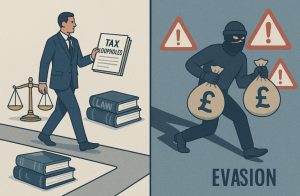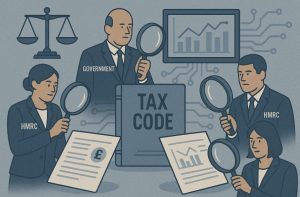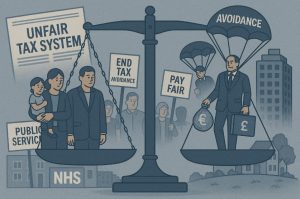
How Much Does Tax Avoidance Cost the UK Each Year?
Tax avoidance remains a pressing concern for the UK government, especially as the demand for increased public funding grows.
While legally distinct from tax evasion, avoidance strategies significantly impact the nation’s finances.
Recent data from HMRC reveals billions in lost revenue, raising questions about the effectiveness of current enforcement measures.
As political parties propose various strategies to close the tax gap, understanding the scale and nature of tax avoidance is critical to shaping future policy and maintaining public trust.
What Is Tax Avoidance and How Does It Differ From Tax Evasion?

Tax avoidance involves exploiting the legal framework of the tax system to reduce liabilities, often in ways that Parliament never intended.
It includes methods like shifting income or profits, using offshore accounts, and employing complex tax planning schemes.
While technically legal, many tax avoidance schemes operate in a grey area, raising concerns about fairness and integrity.
Tax evasion is illegal and involves deliberately misrepresenting financial information. This can include not reporting income, claiming false deductions, or operating unregistered businesses.
One of the key distinctions lies in legality. Avoidance is within the law but often considered unethical, whereas evasion is a criminal offence.
In recent years, public scrutiny has led to a narrowing of the space between avoidance and evasion, as HMRC and Parliament have closed down many loopholes and aggressively challenged borderline tax planning.
How Much Tax Revenue Is Lost to Tax Avoidance in the UK Each Year?
Recent estimates from HM Revenue and Customs (HMRC), published in June 2024, place the annual cost of tax avoidance at £1.8 billion for the tax year 2022–23.
This figure represents a small but significant portion of the total UK tax gap, which stands at £39.8 billion the estimated difference between the tax that should, in theory, be collected and what is actually received.
Understanding the £1.8 Billion Figure
Tax avoidance, as defined by HMRC, involves legally exploiting the tax system to gain an advantage that Parliament never intended.
These schemes often rely on complex financial arrangements, international structuring, or legal loopholes.
While technically within the law, they reduce the effective tax liability of individuals and corporations often on large scales.
Although £1.8 billion is the official figure for avoidance, it’s worth noting that the total tax gap attributed to deliberate and non-deliberate non-compliance is far higher, suggesting that avoidance is just one part of a much broader issue. For comparison:
- Tax evasion cost the UK £5.5 billion
- Failure to take reasonable care cost £12 billion
- Errors added a further £5.8 billion
Given these figures, avoidance accounts for roughly 4.5% of the total tax gap, while mistakes and carelessness combined make up nearly half.
Political Estimates and Projections
In the run-up to the 2024 General Election, several political parties have made bold claims about reducing the tax gap, often using the term “tackling avoidance” as shorthand for broader tax recovery strategies.
This has led to a common misconception that the government is losing £6 billion or more specifically to avoidance, which is not supported by HMRC data.
Here’s how each major party approached the issue:
- Labour projects it can raise £6 billion per year through a combination of increased HMRC staffing, technological upgrades, and legal reforms aimed at reducing tax avoidance, evasion, and error. This would result in a net gain of £5 billion after investing just under £1 billion into HMRC capacity.
- The Conservatives also target £6 billion annually by the end of the next Parliament, with similar investments in enforcement, focusing particularly on areas like umbrella companies and tax advice market regulation.
- The Liberal Democrats estimate £7.23 billion per year in recoverable tax revenue by narrowing the broader £39.8 billion tax gap. Their proposal includes a £1 billion annual investment in HMRC operations.
Despite these ambitious figures, the actual amount attributed directly to tax avoidance remains at £1.8 billion, according to HMRC’s latest methodology.
Tax Avoidance in the Broader Tax Gap Context
It’s important to recognise that political messaging often blurs the lines between avoidance, evasion, error, and non-payment.
In many cases, when parties talk about “clamping down on avoidance,” they are referring to tackling the wider tax gap, which includes multiple behaviours.
The Public Accounts Committee (PAC) and the National Audit Office (NAO) have both indicated that there’s potential for significantly increased tax collection but that it cannot come from eliminating avoidance alone. For example:
- HMRC’s compliance yield revenue collected through enforcement activities has declined from 6% of tax due in 2019–20 to 4.2% in 2022–23.
- The NAO’s Gareth Davies was quoted as saying there are “tens of billions” of recoverable revenue, but this includes evasion, error, and poor compliance not just avoidance.
Breakdown by Tax Type
To understand where avoidance occurs most frequently, it helps to look at the tax types most affected.
While HMRC does not publish a breakdown of avoidance by tax type in its core reports, insights from Parliamentary hearings and public data suggest that Corporation Tax and Income Tax are two of the most common areas.
HMRC Tax Gap by Tax Type (2022–23)
| Tax Type | Estimated Tax Gap (£bn) |
| Income Tax, NICs, and Capital Gains Tax | 13.7 |
| Corporation Tax | 13.7 |
| VAT | 8.1 |
| Excise Duties (e.g., tobacco, alcohol) | 2.5 |
| Other Taxes | 1.8 |
| Total | 39.8 |
Avoidance schemes involving income diversion, capital gains, and corporate profit shifting have been particularly scrutinised by HMRC.
These strategies are often associated with high-net-worth individuals and multinational companies, who have access to bespoke financial and legal advice.
What Role Do Multinational Corporations Play in UK Tax Avoidance?

Multinational companies often reduce their UK tax liabilities by using complex legal structures that shift profits to lower-tax jurisdictions.
This kind of tax planning falls within the scope of avoidance, and though legal, it often runs counter to the intent of tax legislation.
Common strategies used by large firms include:
- Profit shifting through intercompany loans or intellectual property rights
- Exploiting mismatches in international tax rules
- Use of double taxation treaties to avoid paying tax in any jurisdiction
Many of these techniques are scrutinised under international tax reform frameworks like the OECD’s Base Erosion and Profit Shifting (BEPS) initiative.
The UK government has implemented several reforms, including the Digital Services Tax, aimed specifically at digital giants.
The issue is particularly pressing in sectors such as e-commerce and finance, where the physical presence in the UK is minimal, but revenue generation is significant.
While exact figures are not publicly broken down for multinationals alone, corporation tax accounted for £13.7 billion of the total tax gap, and avoidance contributes a notable share of that.
Why Is Tax Avoidance a Problem for the UK Economy?
Tax avoidance, though lawful, has wide-reaching effects on the economy and society. Public resources that could have been invested in health, education, or infrastructure are lost.
The burden of funding government services then shifts disproportionately to individual taxpayers and small businesses.
Economic consequences of tax avoidance include:
- Undermining trust in the tax system
- Reduced investment in public goods
- Competitive disadvantage for businesses that do not engage in avoidance
Avoidance can also distort economic decisions, encouraging firms to invest not where it is most productive, but where it is most tax-efficient. This harms long-term productivity and economic fairness.
Moreover, widespread use of avoidance strategies by high-profile companies and individuals weakens social cohesion.
It sends the message that tax is optional for the wealthy but obligatory for everyone else.
What Measures Has the UK Government Taken to Combat Tax Avoidance?

Over the past two decades, the UK has introduced numerous laws and enforcement mechanisms to limit tax avoidance.
These include both domestic and international initiatives aimed at reducing the incentive and opportunity for aggressive tax planning.
Key interventions include:
- Disclosure of Tax Avoidance Schemes (DOTAS), introduced in 2004, requiring promoters to inform HMRC of new avoidance strategies
- The General Anti-Abuse Rule (GAAR), enacted in 2013, allowing HMRC to challenge tax arrangements deemed abusive
- Accelerated Payment Notices (APNs) and Follower Notices, introduced in 2014, enabling HMRC to demand disputed tax up front
- International data sharing, such as the Common Reporting Standard (CRS), which began in 2017 and provides HMRC with information about offshore accounts
These reforms, along with public pressure and media exposés, have significantly reduced the volume and complexity of avoidance.
In 2005–06, avoidance accounted for £11 per £1,000 of tax due, while in 2022–23, this fell to just £2 per £1,000.
How Effective Are Current Tax Compliance and Enforcement Efforts?
HMRC’s effectiveness has varied over time. While long-term trends show improvement, recent years have posed challenges.
During the COVID-19 pandemic, compliance activity was scaled back, leading to a decline in enforcement outcomes.
From 2019–20 to 2022–23, HMRC’s compliance yield fell from 5.6% to 4.2% of total tax due.
This decline has not yet fully recovered. Staffing shortages, increasing complexity in the tax code, and underinvestment in customer service have all impacted enforcement efforts.
A significant portion of the tax gap now arises from mistakes rather than deliberate avoidance.
According to HMRC, the largest single cause of lost tax revenue is failure to take reasonable care or simple errors in tax reporting.
Tax Gap by Cause (2022–23)
| Behaviour Type | Estimated Loss (£ billion) |
| Failure to take reasonable care | 12.0 |
| Error | 5.8 |
| Legal interpretation | 3.9 |
| Criminal attacks | 3.5 |
| Evasion | 5.5 |
| Hidden economy | 2.2 |
| Avoidance | 1.8 |
| Non-payment | 5.2 |
| Total | 39.8 |
These figures highlight the need to focus not only on deliberate avoidance but also on improving systems to prevent unintentional non-compliance.
What Are the Ethical and Social Implications of Tax Avoidance?

While tax avoidance may follow the letter of the law, it often breaks the spirit. This discrepancy has ethical implications, particularly in times of economic hardship when public services are under pressure.
Social consequences include:
- Erosion of trust in major institutions
- Reduced public willingness to comply voluntarily
- Pressure on governments to over-legislate or increase general tax rates
The reputational risk for companies engaged in aggressive tax planning has increased in recent years.
Public campaigns have successfully pushed several multinational companies to disclose their tax strategies and increase transparency.
There is also a growing expectation that businesses should contribute fairly to the societies in which they operate, regardless of what the law permits.
What Can Be Done to Reduce Tax Avoidance in the UK?
Reducing tax avoidance requires a multifaceted approach that addresses both behaviour and systemic weaknesses. Government reports and independent analysis suggest the following reforms:
- Investment in HMRC customer service to help compliant taxpayers avoid mistakes
- Simplification of the tax code to make it easier to understand and apply
- Continued development of digital systems to detect and prevent tax avoidance early
- Closing legal loopholes that allow aggressive tax planning without technical illegality
- Encouraging corporate transparency and ethical tax strategies
Tax Gap by Taxpayer Type (2022–23)
| Taxpayer Group | Estimated Loss (£ billion) |
| Small businesses | 24.1 |
| Mid-sized businesses | 4.2 |
| Large businesses | 4.3 |
| Individuals | 1.9 |
| Wealthy individuals | 1.9 |
| Criminal groups | 3.5 |
| Total | 39.8 |
These figures reveal that small businesses contribute over 60% of the total tax gap.
While large corporations attract public attention, support for smaller firms in understanding and meeting their obligations is equally vital.
Focusing only on avoidance will not solve the issue. Reducing the tax gap requires a broader strategy that includes legal reform, better administration, and public engagement.
Conclusion
Although tax avoidance directly costs the UK around £1.8 billion per year, the broader tax gap of £39.8 billion encompasses far more, including evasion, errors, and other forms of non-compliance.
The push by political parties to close the gap and recoup an additional £5–7 billion annually rests on both expanding HMRC capacity and modernising the tax system.
Ultimately, tackling tax avoidance is not just about plugging a revenue leak it’s about fairness, trust, and the long-term sustainability of public finances.
FAQs About Tax Avoidance in the UK
What is the difference between tax avoidance and tax evasion in practice?
Tax avoidance is legal and uses loopholes, while tax evasion is illegal and involves deception.
Why is only £1.8 billion of the tax gap attributed to avoidance?
Because most of the gap is due to mistakes, carelessness, and illegal behaviour, not structured tax planning.
Can HMRC really recover an extra £6 billion a year?
Possibly, but only through a wide approach that includes reducing errors and evasion not just avoidance.
How have public attitudes changed towards tax avoidance?
There is greater scrutiny and less tolerance, especially for corporations and high-net-worth individuals.
Do small businesses contribute significantly to the tax gap?
Yes. HMRC data shows small businesses account for over £24 billion of the tax gap.
What is the role of technology in reducing tax avoidance?
AI and data analytics are key to detecting patterns and enforcing compliance more efficiently.
Is the tax gap likely to shrink further in the future?
Yes, but marginal gains are harder to achieve without significant investment and simplification of the system.





